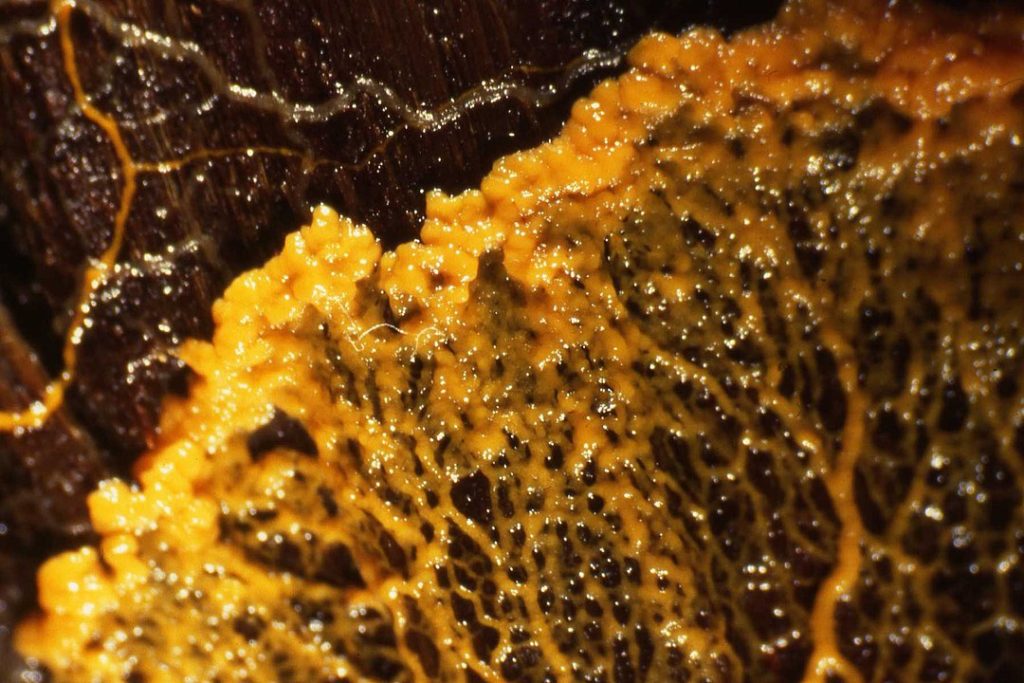
I learned this today. Slime mold is a collection of single-celled organisms that can move, function, and “think” as a single organism.
Slime molds are eukaryotes: cells that have a nucleus enclosed within a nuclear envelope. They usually live as single cells, but they can join together with other cells to create a multicellular organism.
There are more than 900 different species of slime mold in the world, and they are theorized to have evolved over a billion years ago.
Slime mold cells live on their own when there is a lot of food around. It is when food is scarce that they join together to go hunting for it. And this is where things become incredible. When there isn’t enough food, the individual cells will emit a chemical signal that attracts other slime molds. When they are joined together, the cells move as one being, rather than individuals. Slime molds eat microorganisms that live in dead plant material. They can usually be found where vegetation is rotting.
The slime mold is encased in protoplasm. This is where the name “slime” comes from. They contain lots of tubes, like veins, and the protoplasm flows through these as well. They have receptors on this protoplasm that can detect the chemical signals given off by the food they eat. When the scent is detected, calcium ions inside the individual cells make these veins contract. The contraction pushes the protoplasm back, pushing the calcium ions back. This causes the vein to relax, and everything flows forwards, repeating the process. The slow contraction and relaxation allows the slime mold to pulse and slowly move forwards. It travels at about 1.35 mm per second. The receptor that picks up the strongest chemical signal of the food leads the movement. It starts to pulse faster than other veins, meaning the whole mass moves towards the food.
By following the chemical signals towards the food, the slime mold can find the quickest way to the food. It will send out lots of tendrils and if a chemical signal dies out, or turns out to be false, these tendrils will reverse and head back. However, they will leave a trail of protoplasm, marking the area as already searched. By doing this, the slime mold doesn’t search the same place again and can find the shortest path to the food. By doing this, the slime mold demonstrates memory. They can learn and remember paths without having a brain.
Another thing that demonstrates their ability to think is that they can become used to a situation. “Habituation” is where animals become used to something in their environment. The animals “learn” that the thing they have become used to no longer needs paying attention to. For example, if you live by a highway, you will stop hearing the cars. For this to happen, your brain needs to understand that the stimulus it is ignoring is no longer important. Slime molds can do this. Experimenters put food on one side of a small bridge. They put caffeine on the bridge and slime mold this side of the bridge. The slime mold wanted to get to the food, but it hates caffeine, so it took hours for it to reach the food. The experiment was repeated and each day the slime mold was quicker to get to the food. By the sixth day, the slime mold had cut its time in half. It had got used to the caffeine because it knew that there was food on the other side of the bridge. That implies a certain level of intelligence.
The scientists then found that if they took a piece of slime mold that had grown used to caffeine and added it to slime mold that didn’t like caffeine, the new piece would teach the rest and they would cross the bridge. The slime mold communicates.
So, slime mold can move at up to 1.35 mm an hour to hunt for food. It can recognize where a trail is false and backtrack, leaving a signal so it won’t search in the same place twice. It can learn to cope with situations, it can habituate itself to stimuli, and it can communicate. It moves, it talks, and it thinks. What an amazing being. And all of this with no brain. And this is what I learned today.
Sources
https://www.pbs.org/wgbh/nova/article/slime-mold-smart-brainless-cognition/
https://www.scientificamerican.com/article/how-slime-molds-remember-where-they-ate/
https://en.wikipedia.org/wiki/Eukaryote
https://en.wikipedia.org/wiki/Slime_mold
https://www.kqed.org/science/635319/this-pulsating-slime-mold-comes-in-peace
https://www.nature.com/articles/s41598-019-50872-z

